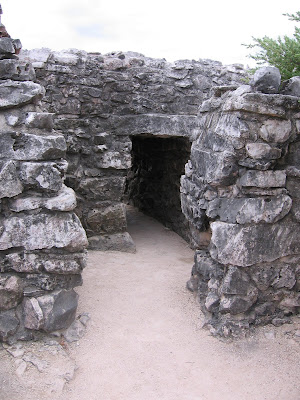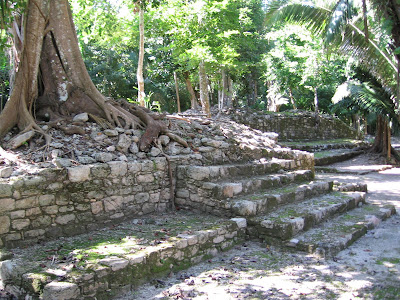My parents took a trip on the Holland America MS Ryndam ship to the western Caribbean to see the Mayan ruins.

The Mayan Cruise began in Tampa, Florida where we joined our ship the Ms Ryndam of the Holland America Line. I've included a photo of our ship plus a few shots of downtown Tampa from the ship. We experienced a somewhat rocky trip across the Western Caribbean Sea to the port of San Miguel on the island of Cozumel. After landing in San Miguel we disembarked walking the long pier to the commercial tenders for the trip to the Mexican mainland and the port of Playa del Carmen where we joined our bus for the trip to the Mayan city of Tulum.
While walking to the bus among the stores and hotels I noticed a small park with lots of shrubs and trees, in among the foliage I saw what appeared to be Mayan ruins, on the way back we had about half an hour to wait in Playa del Carmen so I investigated the park and found three really pretty Mayan temples which appeared to be the exposed tops of Mayan pyramids, the rest of the pyramids appeared to still be buried, later I asked our Mexican-Mayan tour guide about these ruins and he said oh yes there were Mayan ruins there and that the port of Playa del Carmen was build right over them, if I hadn't asked he never would have mentioned them to us, I've included photos of the three pretty little temples.
During the bus ride to Tulum our tour guide mentioned that he was more than half Mayan with the rest of him being Spanish, he was very proud of his Mayan ancestry, he said he spoke the Mayan language along with Spanish and English. He said that Mayan is taught today in schools in the Yucatan states where the Mayans mainly lived and where their descendants still live today. He said his wife was 75% Mayan making his son more Mayan than him.
He said that are more than a hundred indigenous peoples, tribes and languages officially recognized by the Mexican government. He said that all true Mayans had the birth mark on their lower back, he showed us photos of the mark and it appeared to be a large black blotch about the size of one's fist, he said that all tribes related to Maya like the Mixtec, Toltec, Aztec, etc. all had this birth mark and the only other peoples in the world who had this mark were the Mongolians in central Asia of whom he said that all Mayans are descended.
Following are my photos of the Tulum ruins beginning with photos of two of the four entrances through the walls surrounding Tulum, these walls were to keep out any Mayan who wasn't Mayan royalty.

































 My photos of Tulum are here, I went October 7, 2009.
My photos of Tulum are here, I went October 7, 2009.





This part of the cruise took us to the country of Belize formerly British Honduras and is claimed by Guatemala, Guatemala has made attempts to take it. Tiny Belize with a population of about 350,000 people is the only English speaking country in either Central or South America. We landed there and had a bus tour of Belize City, now no longer the capital after a devastating 1961 hurricane, the capital was moved 50 miles inland to a new site. We later proceeded to the Mayan ruins of Altun Ha located in the jungle in what seemed like a long drive from the city. The country of Belize is very poor, people were living in tiny dwellings or shacks pretty much the way their ancestors did. In Belize City there were few worthwhile photo opportunities other than the cruise dock and tourist area which is off limits to the local people but I did manage to include a few shots of the city as well as the cruise ship tourist area stores, all the rest of the photos were taken at Altun Ha. The Mayan ruins of Altun Ha were unique because they contained a temple and round stone where human sacrifices took place, photo no. 97. We were allowed to climb this pyramid along with a few other structures, the pyramid was quite a climb up very uneven steps. The people of Belize are a mixture of Carib and Mayan blood plus some British and African lines but the people appear to be mostly African descent similar to those people found on some Caribbean islands.













 #97
#97






The next phase of our cruise was to us to the island of Roatan, located off the coast of Honduras and owned by Honduras, it's at a private enclave or resort constructed specifically for cruise ships. Although Honduras is the second largest Central American nation, it is among the least populated. Volcanoes and rivers dominate the fertile landscape, a lush rain forest thrives in the environment. Of the islands of Honduras Roatan is the largest, it's 30 miles long and about 3 miles wide. The Spanish first arrived there to find the peaceful Arawak Indians, according to history of the island in one of the buildings the Spanish killed all the male Arawaks and sold the females into slavery. Today cruise ship passengers enjoy the place, I've encluded photos of the resort.











The last stop on our cruise was at Costa Maya on the coast of Mexico. Costa Maya is one of those protected resort new towns of mostly shops that caters only to cruise ships and the locals aren't allowed to enter. The town was created in a sparely populated area of Mexico where there's little in the way of commerce or population. We left the ship and walked on a long pier to the area of shops where we boarded a bus for the Mayan ruins of Chacchoben. Chacchoben was another long dusty and bumpy bus ride which included several stops along the way for police road blocks, evidently police road blocks in every part Mexico is a way of life there, what they're. Our local tour guide said the people were happy with all the road blocks because it kept them safe. The tour guide on this trip was only about a fourth of Mayan blood and talked a lot of his Mayan grandmother. His English and knowledge of the local history was excellent. Each of the Mayan sites has its own distinct differences and with Chacchoben what made it interesting were the archaeologically excavated residential areas where the average Mayan. In the royal enclave of the city I learned that those temples and pyramids were lived in, archaeologists have excavated sleeping pallets in various rooms of the temples and we were able to enter some of those rooms where were quite small, a palm branch roof would have been placed over the rooms and there were some reconstructions showing this. I also learned that there would be Mayan settlements or cities where certain types of trees and palms grew, the palms supplied building material and the roofs for houses and a certain type of tree would supply sap that became something like chewing gum, it's where the term Chiclets comes from. I took photos of these types of trees and on one tree the groves for sap removal can still be distinguished. As with all Mayan cities the wall of separation of the population is there also. Black Warrior ants are shown in photo number 136, one has to watch where you're walking, the Black Warrior ants were at Tulum, longs lines of them marching, stepping on them would be painful so care should be taken when they're around.































 What a great trip and learning experience! Thank you Dad!
What a great trip and learning experience! Thank you Dad!
No comments:
Post a Comment